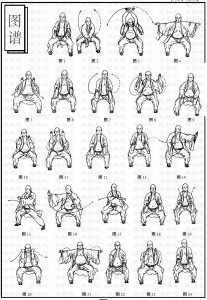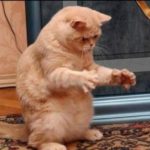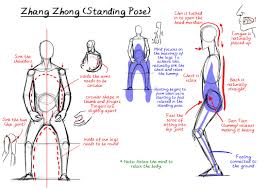Your guide to learning the basics of Tai Chi
What is Zhan Zhuang (pole standing) and how is it different than Qi Gong Meditation?
by Scott
Most styles of internal martial arts incorporate standing meditation as a core component, if not the most important part of their training. While the practices are elegantly simple and instruction on correct posture abounds.


Most students do not maintain a standing practice and never achieve the benefits of Zhan Zhuang. Why is this?
Lack of commitment is normally due to lack of understanding and therefore lack of buy-in.
This essay is a two part series where I will first better define WHAT pole-standing is and then WHY this simple, short practice can have a very positive effect on your life. As a note, I will not go into the hows of practice as each art varies on which standing practice is important to them and how they teach. However, for in-depth instruction or tips, references have been included at the end.

Let’s start with the rough translation(s) of Zhan Zhuang:
- standing-on-stake
- standing qigong
- standing like a tree
- post-standing
- pile-standing
- standing like a post
I like presenting all of the translations of Zhan Zhuang collectively because the important point is what it all hints at. You are assuming a posture that gradually transfers the strain/weight to your lower extremities and gives that sensation that you are cemented to pylons/roots that extend through the ground beneath you.
What is Zhan Zhuang?
Zhan Zhuang is a stance practice in which the body is kept essentially still and mostly upright, though there are some stances where the spine is not vertical.
What is the purpose of Zhan Zhuang?
 The purpose of these standing exercises is to become aware of the body and how it stabilizes itself. You are then able to gain a measure of control over this autonomic process and use it to improve health, posture, and martial abilities. Still too esoteric? Let’s break it down a bit. Normally your stabilizer muscles keep you from falling down. However, this relies on balancing with minute, continual adjustments against gravity. Secondly, the same muscles that stabilizes you also constrict your blood flow. By aligning your posture you are asking you major muscles and your bones to take your bodies weight. This allows the blood to rush freely while you concentrate on your breath and mental presence.
The purpose of these standing exercises is to become aware of the body and how it stabilizes itself. You are then able to gain a measure of control over this autonomic process and use it to improve health, posture, and martial abilities. Still too esoteric? Let’s break it down a bit. Normally your stabilizer muscles keep you from falling down. However, this relies on balancing with minute, continual adjustments against gravity. Secondly, the same muscles that stabilizes you also constrict your blood flow. By aligning your posture you are asking you major muscles and your bones to take your bodies weight. This allows the blood to rush freely while you concentrate on your breath and mental presence.What does Zhan Zhuang feel like?
 Those unfamiliar with Zhan Zhuang can be shocked when they initially experience severe muscle fatigue and “trembling.” You sweat, your mind asks you to stop, and your breathing races if not controlled. For those of you who haven’t yet experienced this, it is shocking and intriguing that you can induce this state in 180 seconds. Once sufficient stamina and strength have been developed the practitioner can use Zhan Zhuang to work on developing ‘opposing forces,’ central equilibrium, and sensitivity to specific areas of tension in the body.
Those unfamiliar with Zhan Zhuang can be shocked when they initially experience severe muscle fatigue and “trembling.” You sweat, your mind asks you to stop, and your breathing races if not controlled. For those of you who haven’t yet experienced this, it is shocking and intriguing that you can induce this state in 180 seconds. Once sufficient stamina and strength have been developed the practitioner can use Zhan Zhuang to work on developing ‘opposing forces,’ central equilibrium, and sensitivity to specific areas of tension in the body.Types of Zhan Zhuang:

The most common Zhan Zhuang method is known as ‘Hun Yuan’ (‘Round Smoothness’) or Chen Bao (‘Tree Hugging’ stance). This posture is entirely Daoist in its origins and has many variations. Zhan Zhuang is also practiced in a deep stance with the left hand aligned behind the back at the ming men and the right hand flat and open in front of the eyes.
How long should pole standing be practiced?
Teachings vary between 2 minutes and 120 minutes. Obviously a lower, more erect posture limits a practitioner to around four minutes. Three minutes of correct posture is enough to shake, feel like you are going to collapse, and raise your body temperature. Chen Qingzhou counseled that you work towards a more perfect three minutes and not on increasing the time. Karel Koskuba in the article: Yiquan – Power of the Mind suggested to begin with 5-10 seconds daily because making the practice habitual and learning how to quiet the mind where initially essential. Yi Quan and many external arts maintain a higher posture and work up to 90 minutes.
Is Zhan Zhuang a Form of Qi Gong?
 Please note that Zhan Zhuang is not considered to be a form of qi gong because of its purpose or intention but is often grouped with qi gong because the practice looks similar. “Many styles, especially the internal styles, combine post standing with qigong training and other coordinated body methods to develop whole body coordination for martial purposes. The martial practice is thought to strengthen the body’s Central Nervous System and develop the coordination required for effective martial performance. In Yi Quan, a clear distinction is made between ‘health postures’ and ‘martially oriented postures’. In Bagua Zhang’s circle walking practice, the upper body is held as a Zhan Zhuang posture, while the lower body is more dynamic.”
Please note that Zhan Zhuang is not considered to be a form of qi gong because of its purpose or intention but is often grouped with qi gong because the practice looks similar. “Many styles, especially the internal styles, combine post standing with qigong training and other coordinated body methods to develop whole body coordination for martial purposes. The martial practice is thought to strengthen the body’s Central Nervous System and develop the coordination required for effective martial performance. In Yi Quan, a clear distinction is made between ‘health postures’ and ‘martially oriented postures’. In Bagua Zhang’s circle walking practice, the upper body is held as a Zhan Zhuang posture, while the lower body is more dynamic.”References on Zhan Zhuang
If you want to know more begin looking here:
 Here is a great cartoon drawing of Zhan Zhuang that is easy to follow: Brisbane Chen Tai Chi
Here is a great cartoon drawing of Zhan Zhuang that is easy to follow: Brisbane Chen Tai Chi- A Zhan Zhuang internet/bibliographic reference for practitioners
- Zhan Zhuang – The Foundation of Internal Martial Arts
- Translation of ‘The Science of Nei Jia Quan’ – a book explaining the mechanics of Nei Gong practice, including that of Zhan Zhuang
- Yiquan – Power of the Mind by Karel Koshuba
Related
Benefits of Standing Meditation – Improve Your Health and Fitness with Zhan ZhuangJanuary 2, 2015In "Improving your Practice"
Reader Interactions
Comments
Footer
WHAT IS TAI CHI?
Tai Chi is a traditional Chinese martial art. It is considered by many to be an 'internal' martial art which primarily uses the dantien or body's center of mass as a source of power.
ABOUT TAICHI BASICS
Tai Chi Basics is an online guide to understanding the fundamentals and practice of the Chinese martial art called Tai Chi.
I am a student of Yang long form traditional style.
I would be delighted to receive your newsletter etc
If you haven’t done so already, subscribe in the upper right corner of the screen and you will be notified when a post is released. We don’t spam and they come out about once a month. Welcome to the conversation.
I will respond and do my best to translate but I haven’t spoken Portuguese for a while. Please put this message in google translate. I believe you shared that you have injuries to your cervical and lumbar areas of your back. Yes Zhan Zhuang can help but there are some important things to keep in mind. I will share a bit here. Know that I am not a doctor so I am suggesting further reading for you. People HAVE healed their back or reduced their cronic pain.
You Are the Placebo is the book (http://www.youaretheplacebo.com/)
Here is a piece in Portuguese: https://www.youtube.com/watch?v=_-qk6yUjkdQ
8 steps to a pain free back by esther gokhale
Vou responder e fazer o meu melhor para traduzir mas eu não falei Português por um tempo. Por favor, coloque esta mensagem Traduz Google. Eu acredito que você compartilhou que você tem lesões nas áreas cervical e lombar das costas. Sim, Zhan Zhuang pode ajudar, mas há algumas coisas importantes a ter em mente. Eu vou compartilhar um pouco aqui. Saiba que eu não sou um médico assim que eu estou sugerindo ainda a leitura para você. As pessoas têm curado suas costas ou reduziram sua dor crônica.
Você é o Placebo é o livro (http://www.youaretheplacebo.com/)
Aqui é uma peça em Português: https://www.youtube.com/watch?v=_-qk6yUjkdQ
8 passos para uma livre da dor traseira por Esther Gokhale
Height: Maintain a high enough posture so that you don’t compromise your injury. You can accomplish what you need to in a near erect posture with soft joints.
Time: Stand for a bit longer than you currently are. Discomfort will often direct your body into a better posture to alleviate leaning or other bad joint relationships.
Zhan Zhuang has many goals and postural differences. Not to mislead you and to give you further reading I am included a couple great resources. This from “The Search for Wu”
There are eight basic standing posts. From the First form up to the Fifth form, all are Basic Healing posts; from the Sixth form to the
Eighth form, all are Basic combat posts. These eight posts are the most commonly used in Zhan Zhuang are arranged according to the ascending order of physical strain required.
The illustrations along with the writing above show continually lower and more contorted postures as you progress through the eight.
The Zhan Zhuang system begins with two basic standing exercises. These start to build up and release the natural flow of energy inside you. The first position, a simple standing posture, enables you to relax your body in preparation for the other exercises. The second position, “Holding the Balloon”, is the key position in the whole system.
yourself as never before, you will not be left gasping grotesquely for air. You will be able to exercise without fighting against yourself.
Yours in health, s
My question for Sprath is what would be the goal of doing higher and longer stances vs lower stances. I assume the lower stance is for martial practice.
Low stances
Health
The lower stance has numerous implications for health. It: raises body temperature, increases bloodflow, can be used to train the breath to be lengthened, innervates the bone marrow in the large bones specifically the femur (bone marrow contains the bodies growth and repair centers – stem cells), and helps us self-diagnose poor posture. On the metaphysical side, the lower stance is described as separating heavy/dark and light qi and moving “stale” qi down while bringing fresh qi in through the top of the head.
Low standing for 3 minutes each day has to be the quickest way to build up leg strength, confidence in stance work, and flexibility. Any stance work should be accompanied by standing meditation. I don’t know how one would learn how to empty-step while maintaining their root without experiencing the heavy sensation that deep standing provides.
Health
The higher stance allows us a lot of time to cultivate internal sensitivity, meditate, and work on long periods of relaxation. Arts that are heavy into standing such as I Chuan (Yi Quan) work up to 60-90 minutes of standing. It would not be beneficial to try to do that in the lower stance. Qi gong sets that build up chi and use chi cannot be done in the lower stance. You can’t concentrate and maintain the stance for the amount of time it takes the internal energy to build up or for a novice to develop.
The higher stance can be used to cultivate awareness of opponents and some of the harder qi gongs and gong fu harden their skin in higher standing postures.
Nerve /MS pain read Brain Maker
Read anything you can on sleep and check out The Model Health Show podcasts. There is a series of shows from the first half of 2016 all on sleep.